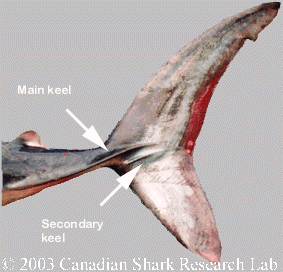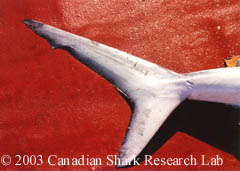Fins
The fins of sharks are used for stabilizing, steering, lift and propulsion. Each of the fins are used in a different manner. There are one or two fins present along the dorsal midline called the first and second dorsal fin. These are anti-roll stabilizing fins. These two fins may, or may not have spines at their origin. When spines are present they are defensive, and may also have skin glands associated with them that produce an irritating substance. Pectoral fins originate behind the head and extend outwards. These fins are used for steering during swimming and help to provide the shark with lift. Pelvic fins are found near the claoca and are also stabilizers. In males they have a secondary function as they are modified into copulatory organs called claspers. Anal fins may be absent, but if present they are located between the pelvic and caudal fins. The tail region itself consists of the caudal peduncle and the caudal fin. The caudal peduncle may have notches known as precaudal pits found just ahead of the caudal fin. The peduncle may also be horizontally flattened into lateral keels. The caudal fin has both an upper and lower lobe that can be of different sizes and the shape varies across species.The primary use of the caudal fin (hetereocercal or homocercal) is to provide thrust. The upper lobe of the caudal fin produces the most thrust, and at least some of that would tend to force the shark downwards. Lift to counter this force is provided by the pectoral fins and the shape of the body (like an airfoil) working together. The strong non-lunate caudal fin (heterocercal) in most benthic shark species allows for unhampered swimming close to the seabed (i.e. nurse sharks and zebra sharks). However, The fastest swimming sharks (such as makos and porbeagles) tend to have lunate shaped caudal fins (homocercal) consistant with the requirement for maximum thrust.

